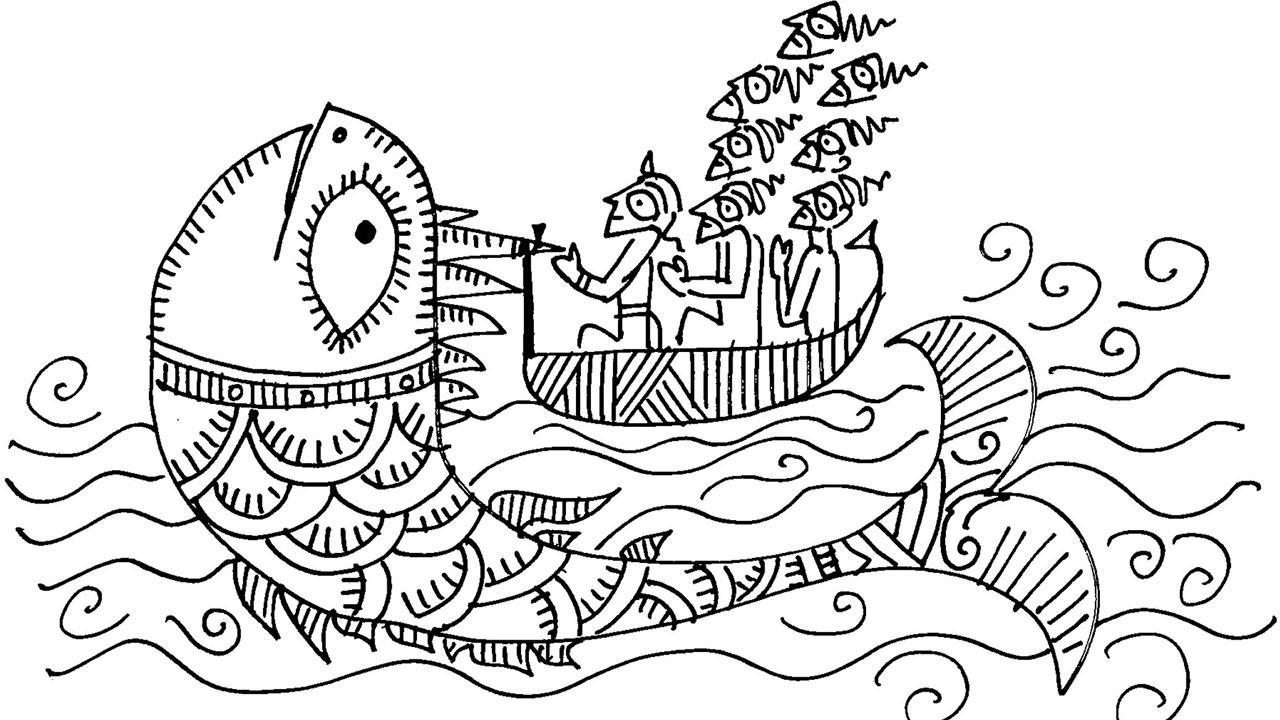This story is also found in Jewish and Islamic myths too.

Illustration/Devdutt Pattanaik
 Many mythologies around the world have a flood myth. But not all flood myths are the same.
Many mythologies around the world have a flood myth. But not all flood myths are the same.
ADVERTISEMENT
The most popular flood myth is the flood associated with Noah in the Old Testament of the Bible. We are told that the world had become wicked and cruel, and Jehovah, the one true god, the creator, got angry. So, he sent a great flood to destroy the world. However, Noah was spared because he was a good man. He was told to build a boat and fill it with the male and female of every species he could find to repopulate the earth after the flood. This story is also found in Jewish and Islamic myths too.
The Biblical tale can be traced to ancient Sumerian mythology. But here it is a group of gods, the Annunaki, who get angry with the noise created by humans, so they send a flood to destroy the Earth. Only Ut-napishtim was allowed to survive, and he survived by creating a boat made of reeds. This story, narrated in the Epic of Gilgamesh, nearly 4,000 years ago, transformed into the story of Noah in the Biblical traditions, 2,500 years ago.
Greeks tell a similar story where we are told that Zeus got angry by the constant warring of men. So, he sent a flood to destroy them all. However, one of the men survived. He was Daedelus. This was due to the intervention of a Titan called Prometheus. Daedalus creates the human race by throwing rocks over his shoulder, which sprout and transform into human beings. The Greek story is clearly an import from its eastern Mesopotamian neighbours.
In all these stories, the flood is the result of a divine wrath—either of one true god or a group of gods. However, if you look at the flood myths which are found in China and India, there is no angry god in the picture.
In China, the great goddess Nu Wa created humans to play with. She made aristocrats using yellow clay and commoners using brown clay. A fight amongst gods destroys the pillars that uphold the heavens, which leads to a downpour that becomes the floods. But then she repairs this breach in the heavens with the help of the legs of a giant turtle and stops the deluge. When it comes to river floods, we learn of the world’s first hydraulic engineer, Yu, who saved the villages and farms by building canals, and was elected to
be Emperor.
Hindu mythology also talks about floods. The earliest reference to it comes from Satapatha Brahmana. It is repeated in the Vishnu Purana, where Manu saves a small fish and helps it grow. Many years later, the small fish manifests as a large gigantic fish. It tells Manu to build a boat for himself to protect himself from a flood. The fish takes Manu and his boat to a safe place on the highest peak of Meru.
Depending on which version of the story you hear the flood is considered a part of Sandhya, or the twilight of the world. The flood is the result of human greed, asking for more water to provide for the growing fish. Here, flood is a natural phenomenon, the result of cultural corruption, part of the ageing process of the world. It has nothing to do with the anger of the gods or the disobedience of humanity. In other words, all flood myths are not the same. Every culture explains it and responds to it differently.
The author writes and lectures on the relevance of mythology in modern times. Reach him at devdutt.pattanaik@mid-day.com
 Subscribe today by clicking the link and stay updated with the latest news!" Click here!
Subscribe today by clicking the link and stay updated with the latest news!" Click here!







